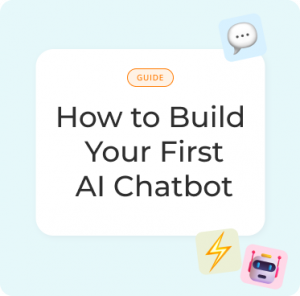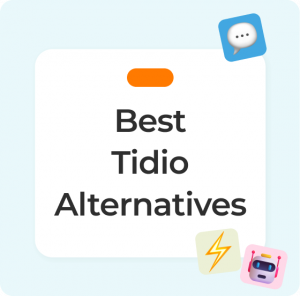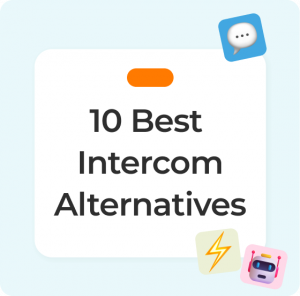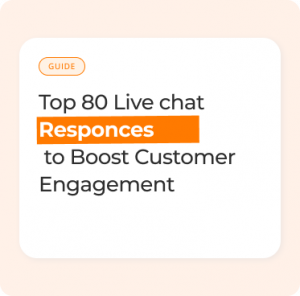10 Best ChatBot.com Alternatives in 2025
If you are researching ChatBot.com alternatives in 2025, you are likely weighing how far a flow builder can take you before you need richer AI, easier omnichannel coverage, and clearer pricing. ChatBot.com popularized visual drag and drop flows that are friendly for beginners. Many teams eventually outgrow tree based scripts and begin evaluating chatbot alternatives that combine brand trained AI, no-code setup, and built in conversion tools.
Who this guide is for. Support, sales, and e-commerce teams that want a practical comparison of visual builders, no-code capabilities, integrations, and pricing patterns before deciding on a ChatBot.com replacement.
Where ChatBot.com fits and where it falls short
Strengths. Clear visual builder, quick starter templates, handoff to human chat, and easy deployment for basic FAQ or lead capture. It suits straightforward flows and small teams that mainly need decision trees.
Limitations that drive teams to consider alternatives.
- Script maintenance. As intents, products, and policies grow, tree based flows require frequent edits. Updates can sprawl across many branches and variants.
- AI depth. Teams want conversational, brand trained AI that handles nuance, not just buttons and quick replies.
- Omnichannel continuity. Customers expect a single experience across web chat, email, and messengers like WhatsApp or Messenger without context resets.
- Conversion features. Many teams want popups and lead magnets in the same tool so they can nudge, capture, and chat from one place.
- Pricing clarity. Buyers prefer predictable usage based or value aligned pricing over complex feature bundles and seat tiers.
Evaluation criteria for chatbot alternatives
- Visual builder quality. Clarity, speed, reusable blocks, testing, and versioning.
- No-code depth. Can non-technical users launch and adjust automations without engineering.
- AI strength. Generative answers, knowledge ingestion, guardrails, and brand tone controls.
- Omnichannel support. Web chat, email, WhatsApp, Messenger, Telegram, and in-app continuity.
- Human handoff. Seamless transitions with transcripts, notes, collision detection, and SLAs.
- E-commerce capabilities. Cart awareness, order status, recommendations, and promo orchestration.
- Integrations. CRM, help desk, analytics, payments, and data export options.
- Pricing transparency. Simple starting tiers, clear limits, and scalable usage fees.
- Security. Roles, logs, SSO options, and data retention controls.
- Reporting. Resolution rate, handoff, conversion impact, and deflection metrics.
Top 10 ChatBot.com alternatives in 2025
These platforms consistently appear on shortlists when teams outgrow scripted flows and need stronger AI or simpler operations. The list begins with Oscar Chat because it combines an AI assistant, human live chat, and a popup builder inside one widget that small teams can run without heavy admin.
1) Oscar Chat
What it is. An all in one conversational platform that blends AI chatbots, live chat, and a no-code popup builder. It is designed to automate up to 90 percent of routine questions and to route the rest to humans with full context. E-commerce and SaaS teams use it to qualify, support, and convert in one place.
- No-code setup. Paste a snippet and go live quickly. Configure assistants and popups without developers.
- Brand trained AI. Upload policies, FAQs, and product docs. Approve answer tone so replies feel on brand.
- Unified widget. Continue conversations across web chat, email, Messenger, WhatsApp, and Telegram.
- Built in conversion. Behavior based popups for signups, promos, and exit intent that connect to chat.
- Analytics. See resolution rates, handoff volume, and chat to sale influence.
Pricing. Starts at €39 per month for one workspace, five users, 1 active AI assistant widget, and 1,000 AI messages. Each additional 1,000 AI messages costs €2.4. Simple and predictable for small teams.
Best for. Small businesses and e-commerce stores that want AI, live chat, and popups in a single, affordable tool.
Roadmap note. Native CRM integrations with platforms like HubSpot or Salesforce are planned for 2026. Teams can pass leads today via webhooks or automation middleware.
2) Intercom
What it is. A customer service platform with messenger, shared inbox, and an AI agent. Suits product led companies that want refined in-app experiences and robust reporting. Pricing is typically per seat with additional usage fees for AI and channels.
3) Drift
What it is. A conversational marketing solution focused on B2B lead qualification and meeting booking. Powerful for ABM and enterprise sales motions that want detailed routing and playbooks. Cost and complexity can be high for small teams.
4) Freshchat by Freshworks
What it is. Live chat and messaging tied into the Freshworks suite. Good for support teams that already use Freshdesk or Freshsales and want unified administration plus AI options.
5) Tidio
What it is. A small business friendly tool with live chat and AI bots. Popular for Shopify and WooCommerce stores. Teams that scale often look for stronger omnichannel continuity and deeper brand trained AI.
6) LiveChat
What it is. A mature live chat product from the company behind ChatBot.com. Known for reliability and analytics. Best if you prefer classic live chat with integrations into a broader stack.
7) Landbot
What it is. A highly visual flow builder for web and WhatsApp experiences. Great for marketing forms and guided journeys. Focus is on design rich flows with increasingly flexible AI blocks.
8) HubSpot Chat
What it is. Conversational tools that tie directly into HubSpot CRM and Marketing Hub. Handy if you already use HubSpot and want simple chat and bots with native reporting.
9) Crisp
What it is. Lightweight live chat, shared inbox, and basic bot automation at startup friendly prices. A solid alternative for small teams that want dependable chat plus a knowledge base connection.
10) Zoho SalesIQ
What it is. Chat and visitor intelligence connected to the Zoho ecosystem. Attractive for companies already standardizing on Zoho CRM and Desk.
Visual builder and no-code comparison
Every team starts with a flow builder. The difference in 2025 is the fusion of flows with generative AI and reusable components that reduce maintenance. Use this table to compare how the leading platforms approach building, testing, and scaling automations without code.
| Platform | Visual flow builder | Generative AI blocks | Knowledge ingestion | Reusable components | Versioning & testing | No-code handoff to human |
|---|---|---|---|---|---|---|
| Oscar Chat | Yes, with quick start recipes | Yes, brand trained responses | Docs, FAQs, site sections | Snippets and templates | Draft, approve, monitor | One click transfer with transcript |
| Intercom | Yes | AI agent and suggested replies | Help center sync | Blocks and tours | Bot testing and analytics | Native inbox handoff |
| Drift | Yes | AI enhancements on higher tiers | Playbook content | Reusable playbooks | A/B testing | Routing to reps |
| Freshchat | Yes | Freddy AI modules | KB sync with Freshdesk | Bot templates | Bot session analytics | Agent inbox tie in |
| Tidio | Yes | Lyro AI responses | FAQ import | Templates | Flow testing | Agent takeover |
| LiveChat | Limited, depends on ChatBot.com pairing | Add ons | HelpDesk or external | Playbooks | Reports | Native handoff |
| Landbot | Strong visual builder | AI nodes available | Docs and URLs | Blocks and bricks | Sandbox and preview | Agent escalation modules |
| HubSpot Chat | Yes | Basic AI assist | CRM and KB sync | Templates | Workflow testing | Conversations inbox |
| Crisp | Yes, lightweight | AI assist elements | KB connect | Scenarios | Bot metrics | Shared inbox |
| Zoho SalesIQ | Yes | Zobot AI blocks | Zoho KB | Templates | Session logs | Zoho Desk handoff |
E-commerce specific comparison
If your buyers live on product pages and checkout, the bot must understand catalog context, promotions, and order status while giving you tools that recover revenue. The table below focuses on what matters to online stores.
| Platform | Cart awareness | Order status & returns | Recommendations | Popups & promos | Channels | Typical fit |
|---|---|---|---|---|---|---|
| Oscar Chat | Detects cart and page context | Workflows or integrations | AI driven cross sell | Built in popup builder | Web, Email, Messenger, WhatsApp, Telegram | SMB and growth stage stores |
| Tidio | Basic triggers | Templates | Bot rules and Lyro | Basic popups | Web, Email | Small stores |
| Gorgias | Shopify deep data | Native order actions | Macros and rules | Forms and campaigns | Email, Chat, Social, SMS | Shopify first brands |
| Intercom | Event based | Integrations | Product tours and suggestions | Outbound messages | Web, App, Email, WhatsApp | Scaled SaaS and retail |
| Freshchat | Triggers | Freshdesk tie in | Freddy AI | Campaign builder | Web, WhatsApp | Support led commerce |
| LiveChat | Scripts and add ons | HelpDesk workflow | Manual or partner apps | Greeting triggers | Web, SMS via add ons | Teams wanting classic chat |
| Landbot | Strong WhatsApp journeys | Connectors or APIs | AI nodes | Campaign like flows | Web, WhatsApp | Campaign led commerce |
| HubSpot Chat | CRM events | Service Hub flows | Basic recommendations | Forms and CTAs | Web, Email | HubSpot centric stores |
| Crisp | Rules | Integrations | Manual prompts | Campaigns via plugins | Web, Email | Lean teams |
| Zoho SalesIQ | Zoho Commerce events | Zoho Desk actions | Templates | Prompts | Web | Zoho ecosystem users |
Pricing patterns and transparency
Exact pricing changes often, so use these patterns to narrow your list and confirm on vendor sites before purchase.
- Per seat pricing. Intercom and LiveChat frequently bill per user. Simple to forecast for small teams, more costly as the team scales.
- Per interaction or per resolution AI fees. Useful when deflection is the goal, but you should estimate volumes carefully.
- Ticket or contact based tiers. Common in e-commerce help desks where monthly ticket limits affect price.
- Usage based messages. Oscar Chat starts at €39 per month, then adds low cost blocks of 1,000 AI messages. This keeps costs aligned with growth and prevents per seat surprises.
When Oscar Chat is the stronger pick over ChatBot.com
1. You want human sounding AI that learns your brand
Instead of managing sprawling decision trees, train Oscar Chat on your policies, FAQs, and product content. Approve sample answers and let the assistant respond naturally with guardrails and tone controls.
2. You need popups and chat inside one widget
Run behavior based popups for email capture, promos, and exit intent. If a visitor engages, continue the conversation in chat without switching tools.
3. You support customers across multiple channels
Keep context as conversations move from your site to Messenger, WhatsApp, or email. Customers avoid repeating themselves and your team avoids duplicate tickets.
4. You are cost conscious and want clarity
Start at €39 and scale with usage. Buy additional message blocks only when automation volume increases. Seats and traffic do not silently push you into higher tiers on the starter plan.
5. You want quick wins this week
Paste the snippet, publish a starter assistant, and turn on a targeted popup for your primary CTA. Many teams go live the same day with measurable deflection and conversion lift.
How to pick your ChatBot.com replacement
- Define goals. Deflection, lead generation, cart recovery, or trial activation. Your goals should map to built in reporting.
- Test the AI. Upload sample policies and product pages. Check tone, accuracy, and guardrails.
- Validate channels. Ensure the tool covers web, email, and messengers your customers use most.
- Assess admin effort. Confirm your team can own the day to day without developers.
- Check pricing alignment. Model costs for peak months and growth scenarios. Avoid surprises tied to seats or hidden add ons.
- Look ahead. Ensure the roadmap matches your future needs for CRM, data exports, and roles.
Bottom line
ChatBot.com remains a solid choice for simple scripted flows. If you want brand trained AI, omnichannel continuity, and conversion tooling without juggling multiple vendors, Oscar Chat stands out in 2025. It pairs a friendly visual builder with human like AI and a popup engine that turns conversations into revenue. Small teams launch fast. Growing teams scale costs with usage rather than seats.
Try Oscar Chat and launch your first assistant today.






